For many men, the struggle with unwanted chest fat can feel like an uphill battle. Those pesky man boobs can turn a simple t-shirt into a wardrobe nightmare. But fear not! With the right exercises and a sprinkle of determination, he can wave goodbye to that unwanted baggage and strut confidently again.
Imagine flexing those pecs instead of hiding them. It’s not just about aesthetics; it’s about feeling good in your own skin. Whether he’s a gym newbie or a seasoned pro, the right workout routine can make all the difference. So let’s dive into the world of exercises that’ll help him reclaim his chest and boost his confidence, one rep at a time.
Exercise to Lose Man Boobs
Man boobs, medically known as Gynecomastia, affect many men and often cause embarrassment. Understanding the underlying causes can help in addressing this condition.
What Causes Man Boobs?
Several factors contribute to the development of man boobs. Excess body fat often results from poor diet and sedentary lifestyles. Genetics may also play a significant role, as some individuals are predisposed to store fat in the chest area. Hormonal imbalances frequently influence breast tissue growth. Additionally, certain medications can lead to this condition by disrupting normal hormonal levels. Awareness of these causes allows for targeted approaches to reduce unwanted chest fat.
The Role of Hormones
Hormones significantly impact the development of man boobs. Testosterone levels are crucial for maintaining muscle mass and regulating fat distribution. When testosterone levels drop or estrogen levels increase, fat accumulation in the chest area may occur. Puberty can also bring temporary hormonal fluctuations that lead to man boobs in younger males. Aging contributes to hormonal changes, often resulting in decreased testosterone. An understanding of these hormonal effects can guide men toward effective solutions for reducing chest fat.
Effective Exercises to Lose Man Boobs

Targeting chest fat requires a combination of cardio workouts and strength training. These exercises help burn calories and build muscle, ultimately leading to fat reduction in the chest area.
Cardio Workouts
Engaging in consistent cardio workouts promotes fat loss and strengthens the heart. Activities like running, cycling, and swimming boost metabolism and enhance overall endurance. Aim for at least 150 minutes of moderate-intensity cardio weekly to achieve optimal results. High-Intensity Interval Training (HIIT) can be particularly effective, burning calories quickly through short bursts of intense exercise followed by rest. Include exercises such as jumping jacks, burpees, or kettlebell swings to keep workouts dynamic and engaging.
Strength Training
Incorporating strength training builds muscle and promotes a toned chest. Focus on exercises that target the pectoral muscles, such as bench presses, push-ups, and dumbbell flyes. Perform these exercises at least twice a week for maximum effect. Start with lighter weights and gradually increase as strength improves. Regularly incorporating bodyweight exercises like dips or incline push-ups can also enhance muscle definition. Encourage full-body strength training as it boosts metabolism, further supporting fat loss across the body.
Diet and Lifestyle Changes

Diet and lifestyle adjustments play a crucial role in reducing chest fat. Implementing healthy changes can enhance results from exercise routines.
Nutritional Tips
Prioritize a balanced diet rich in whole foods, vegetables, and lean proteins. Avoid processed foods high in added sugars and unhealthy fats. Incorporate fiber-dense foods like beans, oatmeal, and leafy greens, as they promote satiety and aid weight management. Aim for meals that include protein sources such as chicken, fish, and legumes to support muscle repair and growth while reducing fat. Consider smaller portions throughout the day to stabilize energy levels. Following these nutritional guidelines helps target excess fat effectively.
The Importance of Hydration
Staying hydrated is vital for overall health and weight management. Water consumption around 8 to 10 cups daily supports metabolism and aids in fat loss. Replace sugary beverages with water or herbal teas to reduce calorie intake. Drinking water before meals can help control appetite and prevent overeating. Hydration also promotes optimal physical performance during workouts, which enhances calorie burning. Prioritizing hydration leads to better energy levels and overall health improvements.
Creating an Exercise Plan

Creating a structured exercise plan plays a crucial role in effectively targeting excess chest fat. Focus on consistency and dedication to achieve visible results.
Frequency and Duration
Working out at least four to five times a week yields noticeable improvements. Each session should last between 30 to 60 minutes. Engaging in both cardio and strength training maximizes fat loss and muscle toning. For cardio, aim for 150 minutes of moderate-intensity activity weekly. Incorporating short, high-intensity sessions enhances calorie burning. Strength training should occur at least two times a week, concentrating on pectoral exercises. Effective options include bench presses and push-ups. This combination fosters better results over time.
Tracking Progress
Monitoring progress helps maintain motivation and accountability. Using a journal or mobile app to log workouts, weight, and measurements ensures clarity. Taking body measurements, specifically around the chest, provides insight into targeted fat reduction. Weekly weigh-ins can serve as additional motivation while keeping expectations realistic. Documenting workout performance, like repetitions or weights lifted, illustrates improvements in strength. Regularly assessing progress focuses efforts and encourages continuous commitment.
Embracing the Journey
Achieving a toned chest and reducing unwanted fat isn’t just about aesthetics; it’s about boosting confidence and overall well-being. By committing to a structured exercise routine that combines cardio and strength training, men can effectively tackle the issue of man boobs.
Incorporating dietary changes and maintaining a healthy lifestyle further supports these fitness goals. Staying consistent and tracking progress can make a significant difference in motivation and results. With determination and the right approach, transforming one’s physique is entirely possible. Embracing this journey not only enhances physical appearance but also contributes to a healthier and more fulfilling life.

